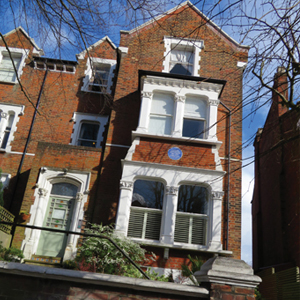Independence Day: London’s India House: A storied hub of the Independence Movement

This stately mansion, in a nondescript part of London, was a powerhouse of activism by luminaries of the freedom struggle and drew visitors such as the grand old man of India, Dadabhai Naoroji as well as Gandhi, the Mahatma himself.
Often, during summers in London, visiting my son and his family, I have ventured out exploring on my own.
Two years ago, my penchant for solo exploration had me visiting the India House located on 65 Cromwell Avenue in Highgate, London (Not be confused with the India House at Aldwych in London, the location of the High Commission of India).
India House in Highgate, London. It opened as a student hostel in 1905. (Photo: Partha Sircar)
The house, in fact a mansion, in a quiet neighborhood, betrays little of its storied history as a hub of some intense activity in the early part of last century, connected with the Indian Independence Movement. Today the only thing that distinguishes it from the neighboring houses is a characteristic circular blue plaque put up by the City of London, saying “Vinayak Damodar Savarkar (1883-1966), Indian Patriot and Philosopher lived here.”
The India House opened in 1905 as a student hostel under the patronage of Shyamji Krishna Varma, a well-heeled lawyer and a staunch patriot who used the place to promote nationalism among Indian students in London. Its inauguration was attended by none other than the grand old man of India, Dadabhai Naoroji, a founding member and former President of the Indian National Congress as well a two-time member of the British Parliament.
The mansion also served as the headquarters for several organizations, the first of which was the Indian Home Rule Society (IHRS), also founded by Krishna Varma.
The building rapidly became a hub for political activism, and for the next five years, was one of the most prominent places for overseas revolutionary Indian nationalism—like the Ghadar movement on the west coast of America.
A number of prominent Indian revolutionaries and nationalists were associated with India House, including Vinayak Damodar (Veer) Savarkar, Bhikaji Cama, V.N. Chatterjee, Lala Har Dayal, V.V.S. Aiyar, M.P.T. Acharya and P.M. Bapat. They were all highly educated and came from well-to-do families. They also came from all corners of India: a Gujarati, a Parsee, a Maharashtrian, a Bengali, a Tamilian, one from Uttar Pradesh and a Punjabi.
One of the important activities of the India House was the publication of the newspaper, The Indian Sociologist, which promoted the views of the Indian Home Rule. However, the newspaper caught the wrath of the British authorities and Krishna Varma fled to Paris in 1907. Veer Savarkar, already a resident of India House, took over the leadership. He had the opportunity to promote his more radical ideas and gain considerable influence among the young men.
It is reported that Mohandas (later Mahatma) Gandhi, then largely unknown, had visited the India House where they exchanged their views on the emancipation of India. Some have suggested that these discussions convinced Gandhi of Nonviolent Resistance as the way forward.
Soon, the matters came to a head. In 1909, a member of India House, Madan Lal Dhingra, assassinated Sir William Hutt Curzon Wyllie, political aide-de-camp to the Secretary of State for India, at a meeting of Indian students in the Imperial Institute in London. Dhingra was arrested, and later tried and executed. Savarkar was suspected of arousing the passion in Dhingra and others and was promptly arrested and incarcerated.
Increased surveillance by the police on the Indian students in the aftermath of the assassination soon led to the dismantling of the activities of the India House. Many of the important members fled Britain—some to France, some to Germany and some to India. Most of them continued their activities associated with the struggle for freeing their motherland from their new homes.
A replica of the India House has been recreated in Mandvi, Gujarat, the birthplace of Shyamji Krishna Varma. It was opened in 2010.
A retired civil engineer based in Concord, California, Partha Sircar enjoys freelance writing. He can be reached by e-mail at psircar@yahoo.com
Enjoyed reading Khabar magazine? Subscribe to Khabar and get a full digital copy of this Indian-American community magazine.
blog comments powered by Disqus












